Nursing Care Plan: Introduction for Elderly Patient Ms. Islam
VerifiedAdded on 2020/05/28
|6
|1872
|48
Report
AI Summary
This report details a nursing care plan for Ms. Islam, a 78-year-old geriatric patient residing in a healthcare setting, focusing on her history of falls and psychological abnormalities, including depression and mood disorder. The introduction outlines the patient's background, medical history, and the circumstances leading to her admission, including a fall resulting in fractures. The report emphasizes the prevalence of falls and depression among the elderly, referencing relevant research on contributing factors such as poor lighting, mobility issues, and social isolation. It also introduces the Tidal Model, a mental health recovery model used to promote mental well-being. The assignment analyzes the patient's condition through social, psychological, cognitive, and physical factors. The report references relevant literature on elderly falls, mood disorders, and the Tidal Model, providing a comprehensive overview of the patient's case and the nursing care plan development.
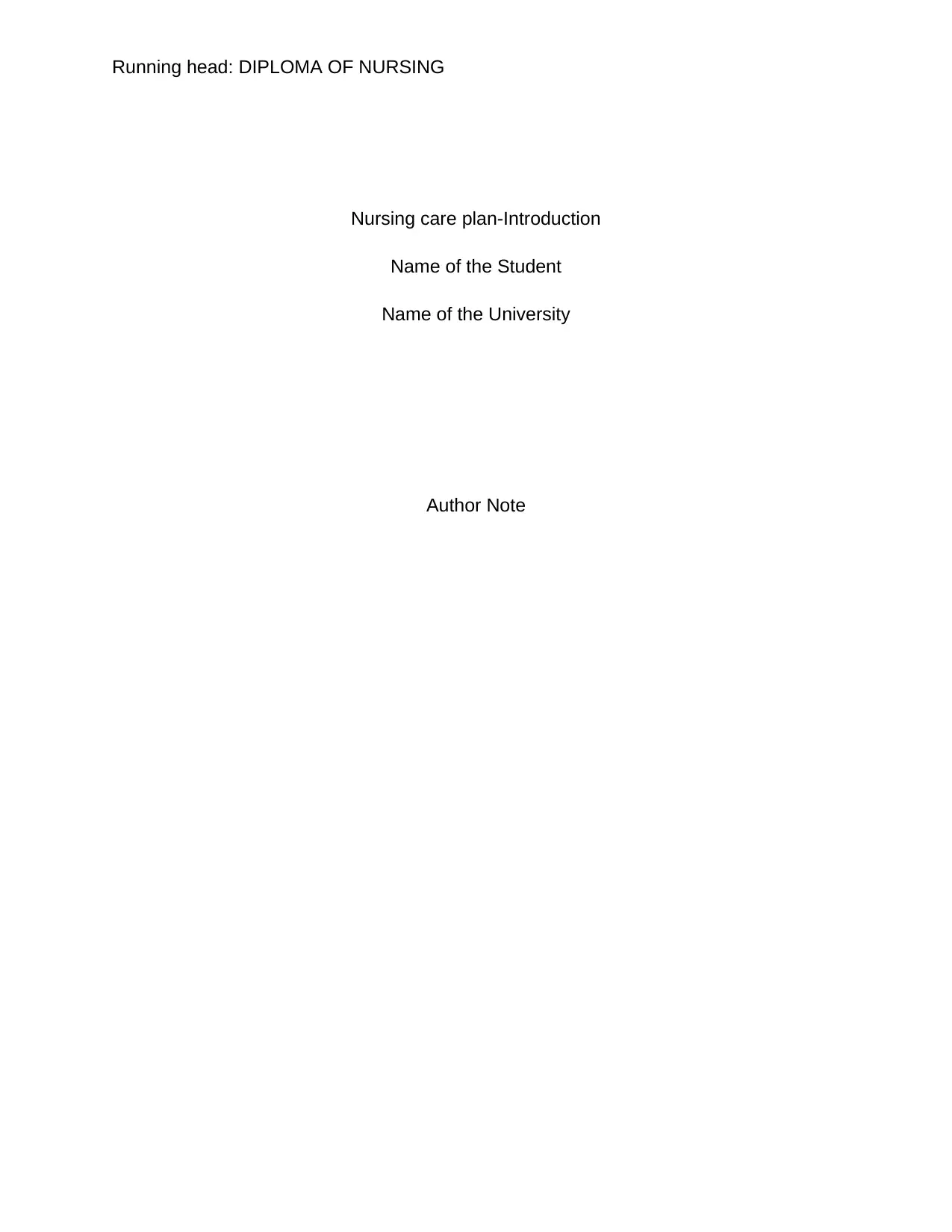
Running head: DIPLOMA OF NURSING
Nursing care plan-Introduction
Name of the Student
Name of the University
Author Note
Nursing care plan-Introduction
Name of the Student
Name of the University
Author Note
Paraphrase This Document
Need a fresh take? Get an instant paraphrase of this document with our AI Paraphraser
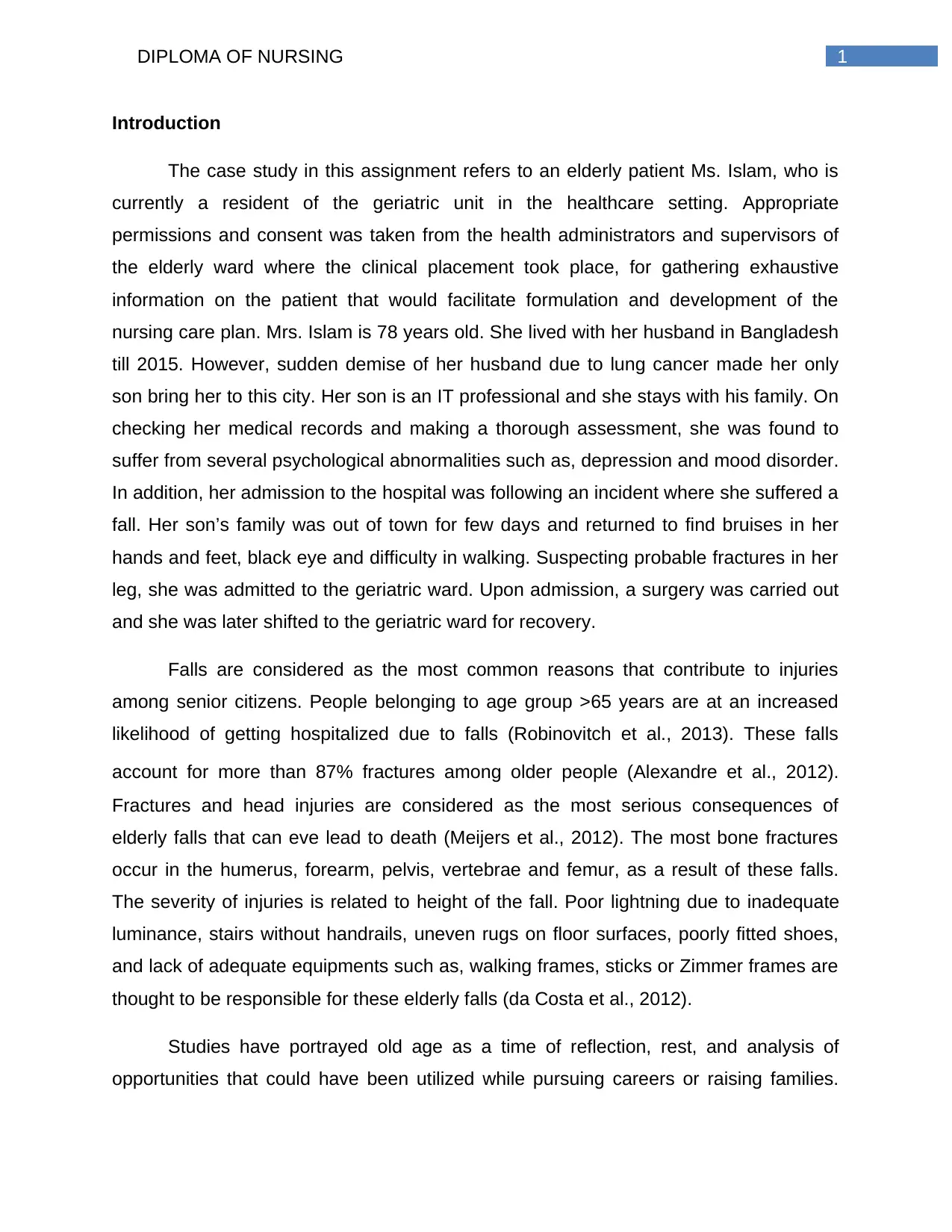
1DIPLOMA OF NURSING
Introduction
The case study in this assignment refers to an elderly patient Ms. Islam, who is
currently a resident of the geriatric unit in the healthcare setting. Appropriate
permissions and consent was taken from the health administrators and supervisors of
the elderly ward where the clinical placement took place, for gathering exhaustive
information on the patient that would facilitate formulation and development of the
nursing care plan. Mrs. Islam is 78 years old. She lived with her husband in Bangladesh
till 2015. However, sudden demise of her husband due to lung cancer made her only
son bring her to this city. Her son is an IT professional and she stays with his family. On
checking her medical records and making a thorough assessment, she was found to
suffer from several psychological abnormalities such as, depression and mood disorder.
In addition, her admission to the hospital was following an incident where she suffered a
fall. Her son’s family was out of town for few days and returned to find bruises in her
hands and feet, black eye and difficulty in walking. Suspecting probable fractures in her
leg, she was admitted to the geriatric ward. Upon admission, a surgery was carried out
and she was later shifted to the geriatric ward for recovery.
Falls are considered as the most common reasons that contribute to injuries
among senior citizens. People belonging to age group >65 years are at an increased
likelihood of getting hospitalized due to falls (Robinovitch et al., 2013). These falls
account for more than 87% fractures among older people (Alexandre et al., 2012).
Fractures and head injuries are considered as the most serious consequences of
elderly falls that can eve lead to death (Meijers et al., 2012). The most bone fractures
occur in the humerus, forearm, pelvis, vertebrae and femur, as a result of these falls.
The severity of injuries is related to height of the fall. Poor lightning due to inadequate
luminance, stairs without handrails, uneven rugs on floor surfaces, poorly fitted shoes,
and lack of adequate equipments such as, walking frames, sticks or Zimmer frames are
thought to be responsible for these elderly falls (da Costa et al., 2012).
Studies have portrayed old age as a time of reflection, rest, and analysis of
opportunities that could have been utilized while pursuing careers or raising families.
Introduction
The case study in this assignment refers to an elderly patient Ms. Islam, who is
currently a resident of the geriatric unit in the healthcare setting. Appropriate
permissions and consent was taken from the health administrators and supervisors of
the elderly ward where the clinical placement took place, for gathering exhaustive
information on the patient that would facilitate formulation and development of the
nursing care plan. Mrs. Islam is 78 years old. She lived with her husband in Bangladesh
till 2015. However, sudden demise of her husband due to lung cancer made her only
son bring her to this city. Her son is an IT professional and she stays with his family. On
checking her medical records and making a thorough assessment, she was found to
suffer from several psychological abnormalities such as, depression and mood disorder.
In addition, her admission to the hospital was following an incident where she suffered a
fall. Her son’s family was out of town for few days and returned to find bruises in her
hands and feet, black eye and difficulty in walking. Suspecting probable fractures in her
leg, she was admitted to the geriatric ward. Upon admission, a surgery was carried out
and she was later shifted to the geriatric ward for recovery.
Falls are considered as the most common reasons that contribute to injuries
among senior citizens. People belonging to age group >65 years are at an increased
likelihood of getting hospitalized due to falls (Robinovitch et al., 2013). These falls
account for more than 87% fractures among older people (Alexandre et al., 2012).
Fractures and head injuries are considered as the most serious consequences of
elderly falls that can eve lead to death (Meijers et al., 2012). The most bone fractures
occur in the humerus, forearm, pelvis, vertebrae and femur, as a result of these falls.
The severity of injuries is related to height of the fall. Poor lightning due to inadequate
luminance, stairs without handrails, uneven rugs on floor surfaces, poorly fitted shoes,
and lack of adequate equipments such as, walking frames, sticks or Zimmer frames are
thought to be responsible for these elderly falls (da Costa et al., 2012).
Studies have portrayed old age as a time of reflection, rest, and analysis of
opportunities that could have been utilized while pursuing careers or raising families.
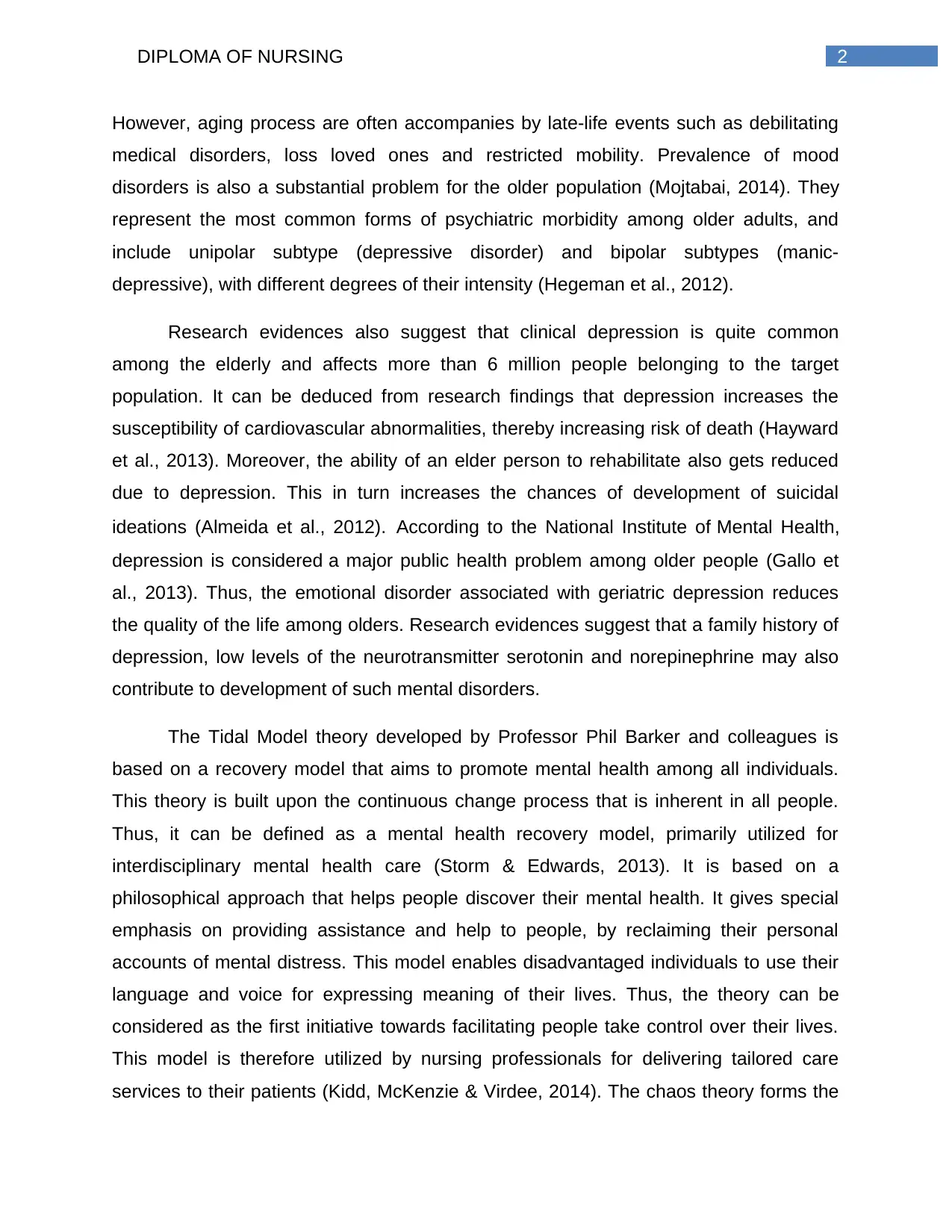
2DIPLOMA OF NURSING
However, aging process are often accompanies by late-life events such as debilitating
medical disorders, loss loved ones and restricted mobility. Prevalence of mood
disorders is also a substantial problem for the older population (Mojtabai, 2014). They
represent the most common forms of psychiatric morbidity among older adults, and
include unipolar subtype (depressive disorder) and bipolar subtypes (manic-
depressive), with different degrees of their intensity (Hegeman et al., 2012).
Research evidences also suggest that clinical depression is quite common
among the elderly and affects more than 6 million people belonging to the target
population. It can be deduced from research findings that depression increases the
susceptibility of cardiovascular abnormalities, thereby increasing risk of death (Hayward
et al., 2013). Moreover, the ability of an elder person to rehabilitate also gets reduced
due to depression. This in turn increases the chances of development of suicidal
ideations (Almeida et al., 2012). According to the National Institute of Mental Health,
depression is considered a major public health problem among older people (Gallo et
al., 2013). Thus, the emotional disorder associated with geriatric depression reduces
the quality of the life among olders. Research evidences suggest that a family history of
depression, low levels of the neurotransmitter serotonin and norepinephrine may also
contribute to development of such mental disorders.
The Tidal Model theory developed by Professor Phil Barker and colleagues is
based on a recovery model that aims to promote mental health among all individuals.
This theory is built upon the continuous change process that is inherent in all people.
Thus, it can be defined as a mental health recovery model, primarily utilized for
interdisciplinary mental health care (Storm & Edwards, 2013). It is based on a
philosophical approach that helps people discover their mental health. It gives special
emphasis on providing assistance and help to people, by reclaiming their personal
accounts of mental distress. This model enables disadvantaged individuals to use their
language and voice for expressing meaning of their lives. Thus, the theory can be
considered as the first initiative towards facilitating people take control over their lives.
This model is therefore utilized by nursing professionals for delivering tailored care
services to their patients (Kidd, McKenzie & Virdee, 2014). The chaos theory forms the
However, aging process are often accompanies by late-life events such as debilitating
medical disorders, loss loved ones and restricted mobility. Prevalence of mood
disorders is also a substantial problem for the older population (Mojtabai, 2014). They
represent the most common forms of psychiatric morbidity among older adults, and
include unipolar subtype (depressive disorder) and bipolar subtypes (manic-
depressive), with different degrees of their intensity (Hegeman et al., 2012).
Research evidences also suggest that clinical depression is quite common
among the elderly and affects more than 6 million people belonging to the target
population. It can be deduced from research findings that depression increases the
susceptibility of cardiovascular abnormalities, thereby increasing risk of death (Hayward
et al., 2013). Moreover, the ability of an elder person to rehabilitate also gets reduced
due to depression. This in turn increases the chances of development of suicidal
ideations (Almeida et al., 2012). According to the National Institute of Mental Health,
depression is considered a major public health problem among older people (Gallo et
al., 2013). Thus, the emotional disorder associated with geriatric depression reduces
the quality of the life among olders. Research evidences suggest that a family history of
depression, low levels of the neurotransmitter serotonin and norepinephrine may also
contribute to development of such mental disorders.
The Tidal Model theory developed by Professor Phil Barker and colleagues is
based on a recovery model that aims to promote mental health among all individuals.
This theory is built upon the continuous change process that is inherent in all people.
Thus, it can be defined as a mental health recovery model, primarily utilized for
interdisciplinary mental health care (Storm & Edwards, 2013). It is based on a
philosophical approach that helps people discover their mental health. It gives special
emphasis on providing assistance and help to people, by reclaiming their personal
accounts of mental distress. This model enables disadvantaged individuals to use their
language and voice for expressing meaning of their lives. Thus, the theory can be
considered as the first initiative towards facilitating people take control over their lives.
This model is therefore utilized by nursing professionals for delivering tailored care
services to their patients (Kidd, McKenzie & Virdee, 2014). The chaos theory forms the
⊘ This is a preview!⊘
Do you want full access?
Subscribe today to unlock all pages.

Trusted by 1+ million students worldwide
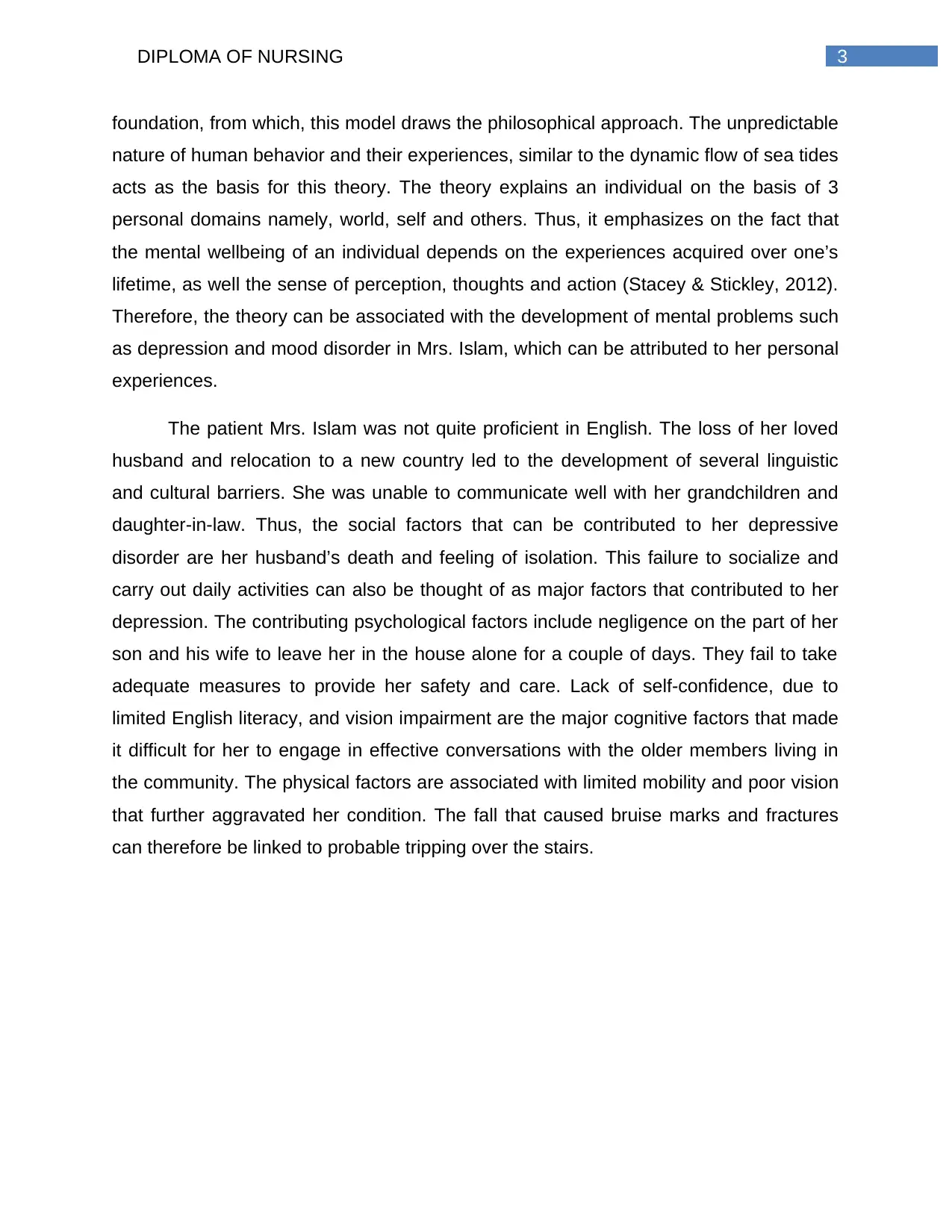
3DIPLOMA OF NURSING
foundation, from which, this model draws the philosophical approach. The unpredictable
nature of human behavior and their experiences, similar to the dynamic flow of sea tides
acts as the basis for this theory. The theory explains an individual on the basis of 3
personal domains namely, world, self and others. Thus, it emphasizes on the fact that
the mental wellbeing of an individual depends on the experiences acquired over one’s
lifetime, as well the sense of perception, thoughts and action (Stacey & Stickley, 2012).
Therefore, the theory can be associated with the development of mental problems such
as depression and mood disorder in Mrs. Islam, which can be attributed to her personal
experiences.
The patient Mrs. Islam was not quite proficient in English. The loss of her loved
husband and relocation to a new country led to the development of several linguistic
and cultural barriers. She was unable to communicate well with her grandchildren and
daughter-in-law. Thus, the social factors that can be contributed to her depressive
disorder are her husband’s death and feeling of isolation. This failure to socialize and
carry out daily activities can also be thought of as major factors that contributed to her
depression. The contributing psychological factors include negligence on the part of her
son and his wife to leave her in the house alone for a couple of days. They fail to take
adequate measures to provide her safety and care. Lack of self-confidence, due to
limited English literacy, and vision impairment are the major cognitive factors that made
it difficult for her to engage in effective conversations with the older members living in
the community. The physical factors are associated with limited mobility and poor vision
that further aggravated her condition. The fall that caused bruise marks and fractures
can therefore be linked to probable tripping over the stairs.
foundation, from which, this model draws the philosophical approach. The unpredictable
nature of human behavior and their experiences, similar to the dynamic flow of sea tides
acts as the basis for this theory. The theory explains an individual on the basis of 3
personal domains namely, world, self and others. Thus, it emphasizes on the fact that
the mental wellbeing of an individual depends on the experiences acquired over one’s
lifetime, as well the sense of perception, thoughts and action (Stacey & Stickley, 2012).
Therefore, the theory can be associated with the development of mental problems such
as depression and mood disorder in Mrs. Islam, which can be attributed to her personal
experiences.
The patient Mrs. Islam was not quite proficient in English. The loss of her loved
husband and relocation to a new country led to the development of several linguistic
and cultural barriers. She was unable to communicate well with her grandchildren and
daughter-in-law. Thus, the social factors that can be contributed to her depressive
disorder are her husband’s death and feeling of isolation. This failure to socialize and
carry out daily activities can also be thought of as major factors that contributed to her
depression. The contributing psychological factors include negligence on the part of her
son and his wife to leave her in the house alone for a couple of days. They fail to take
adequate measures to provide her safety and care. Lack of self-confidence, due to
limited English literacy, and vision impairment are the major cognitive factors that made
it difficult for her to engage in effective conversations with the older members living in
the community. The physical factors are associated with limited mobility and poor vision
that further aggravated her condition. The fall that caused bruise marks and fractures
can therefore be linked to probable tripping over the stairs.
Paraphrase This Document
Need a fresh take? Get an instant paraphrase of this document with our AI Paraphraser
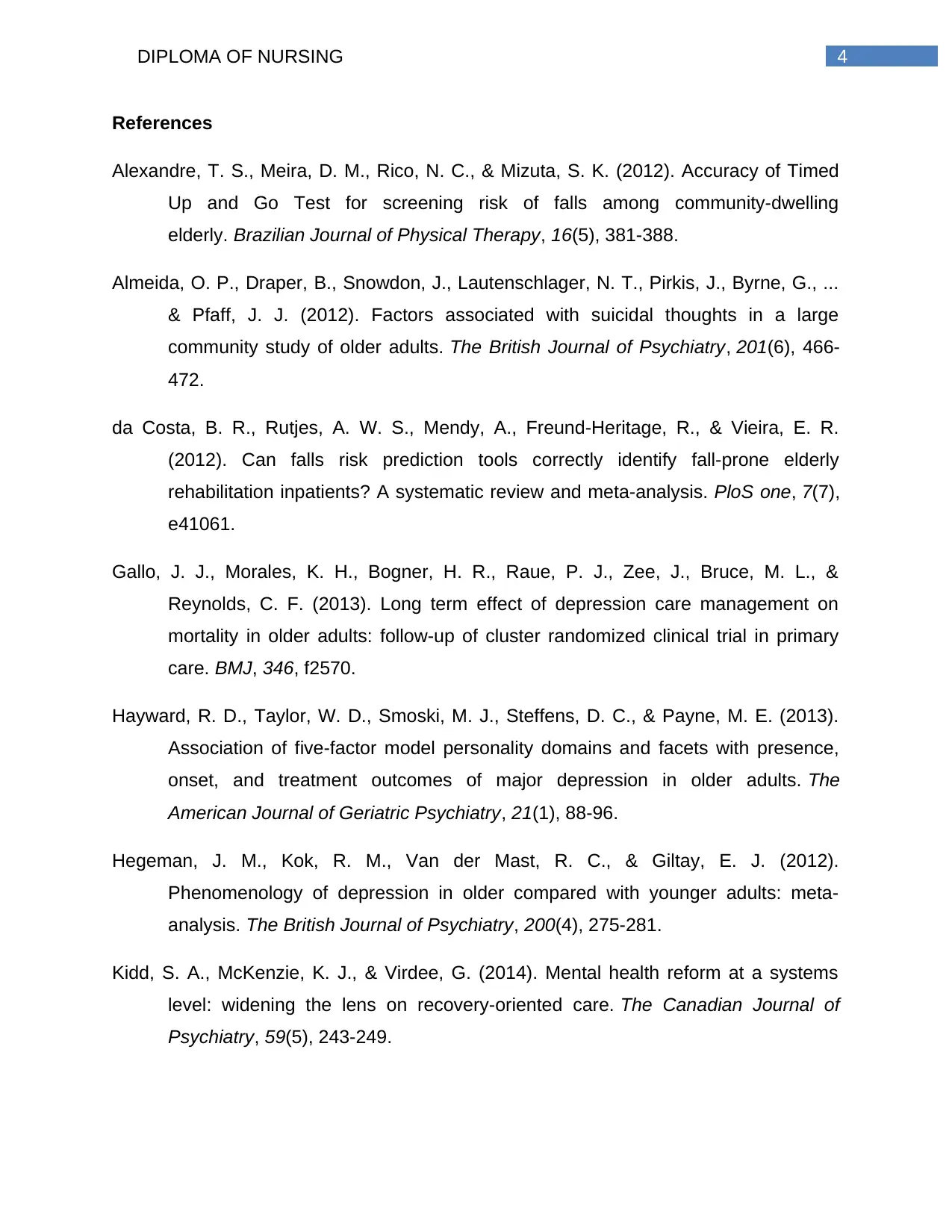
4DIPLOMA OF NURSING
References
Alexandre, T. S., Meira, D. M., Rico, N. C., & Mizuta, S. K. (2012). Accuracy of Timed
Up and Go Test for screening risk of falls among community-dwelling
elderly. Brazilian Journal of Physical Therapy, 16(5), 381-388.
Almeida, O. P., Draper, B., Snowdon, J., Lautenschlager, N. T., Pirkis, J., Byrne, G., ...
& Pfaff, J. J. (2012). Factors associated with suicidal thoughts in a large
community study of older adults. The British Journal of Psychiatry, 201(6), 466-
472.
da Costa, B. R., Rutjes, A. W. S., Mendy, A., Freund-Heritage, R., & Vieira, E. R.
(2012). Can falls risk prediction tools correctly identify fall-prone elderly
rehabilitation inpatients? A systematic review and meta-analysis. PloS one, 7(7),
e41061.
Gallo, J. J., Morales, K. H., Bogner, H. R., Raue, P. J., Zee, J., Bruce, M. L., &
Reynolds, C. F. (2013). Long term effect of depression care management on
mortality in older adults: follow-up of cluster randomized clinical trial in primary
care. BMJ, 346, f2570.
Hayward, R. D., Taylor, W. D., Smoski, M. J., Steffens, D. C., & Payne, M. E. (2013).
Association of five-factor model personality domains and facets with presence,
onset, and treatment outcomes of major depression in older adults. The
American Journal of Geriatric Psychiatry, 21(1), 88-96.
Hegeman, J. M., Kok, R. M., Van der Mast, R. C., & Giltay, E. J. (2012).
Phenomenology of depression in older compared with younger adults: meta-
analysis. The British Journal of Psychiatry, 200(4), 275-281.
Kidd, S. A., McKenzie, K. J., & Virdee, G. (2014). Mental health reform at a systems
level: widening the lens on recovery-oriented care. The Canadian Journal of
Psychiatry, 59(5), 243-249.
References
Alexandre, T. S., Meira, D. M., Rico, N. C., & Mizuta, S. K. (2012). Accuracy of Timed
Up and Go Test for screening risk of falls among community-dwelling
elderly. Brazilian Journal of Physical Therapy, 16(5), 381-388.
Almeida, O. P., Draper, B., Snowdon, J., Lautenschlager, N. T., Pirkis, J., Byrne, G., ...
& Pfaff, J. J. (2012). Factors associated with suicidal thoughts in a large
community study of older adults. The British Journal of Psychiatry, 201(6), 466-
472.
da Costa, B. R., Rutjes, A. W. S., Mendy, A., Freund-Heritage, R., & Vieira, E. R.
(2012). Can falls risk prediction tools correctly identify fall-prone elderly
rehabilitation inpatients? A systematic review and meta-analysis. PloS one, 7(7),
e41061.
Gallo, J. J., Morales, K. H., Bogner, H. R., Raue, P. J., Zee, J., Bruce, M. L., &
Reynolds, C. F. (2013). Long term effect of depression care management on
mortality in older adults: follow-up of cluster randomized clinical trial in primary
care. BMJ, 346, f2570.
Hayward, R. D., Taylor, W. D., Smoski, M. J., Steffens, D. C., & Payne, M. E. (2013).
Association of five-factor model personality domains and facets with presence,
onset, and treatment outcomes of major depression in older adults. The
American Journal of Geriatric Psychiatry, 21(1), 88-96.
Hegeman, J. M., Kok, R. M., Van der Mast, R. C., & Giltay, E. J. (2012).
Phenomenology of depression in older compared with younger adults: meta-
analysis. The British Journal of Psychiatry, 200(4), 275-281.
Kidd, S. A., McKenzie, K. J., & Virdee, G. (2014). Mental health reform at a systems
level: widening the lens on recovery-oriented care. The Canadian Journal of
Psychiatry, 59(5), 243-249.
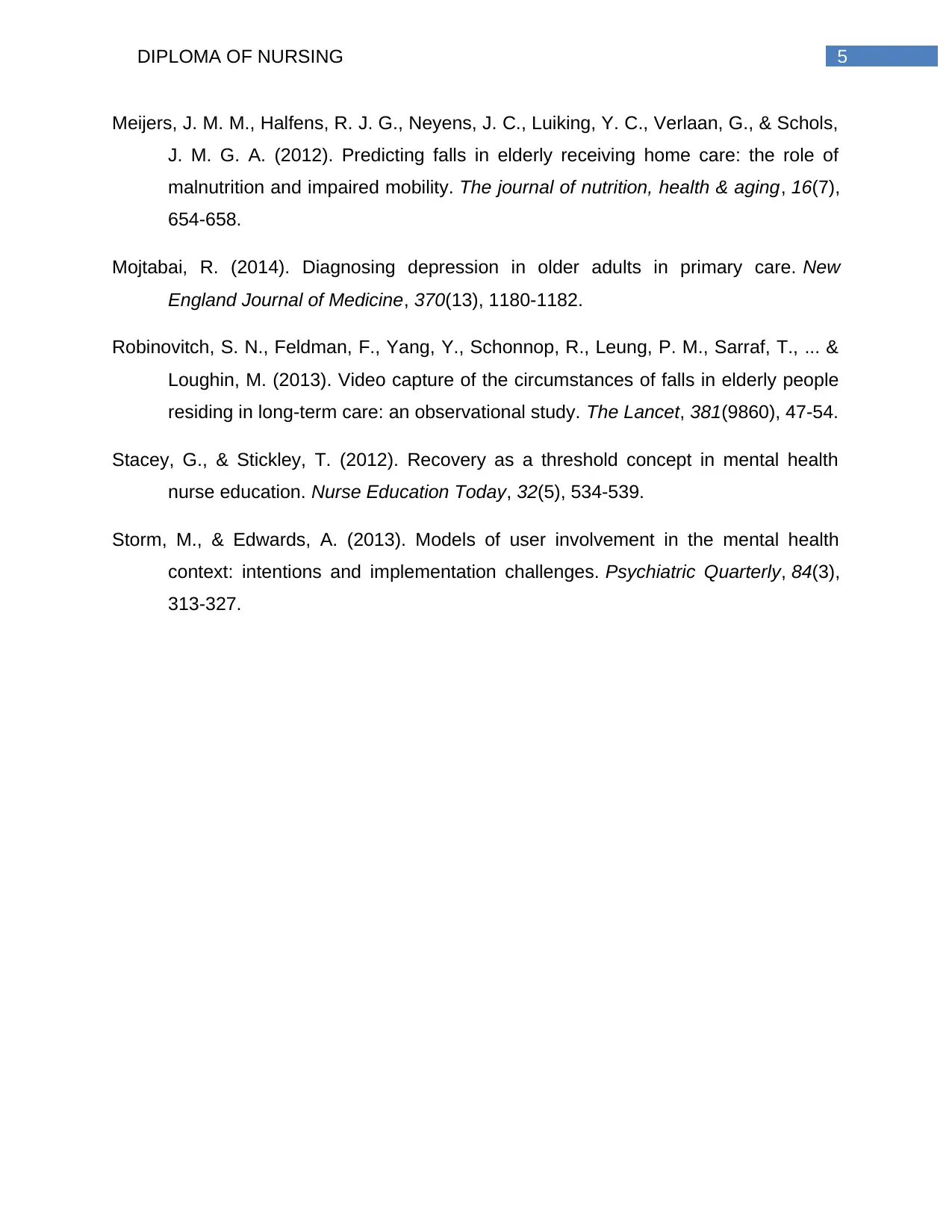
5DIPLOMA OF NURSING
Meijers, J. M. M., Halfens, R. J. G., Neyens, J. C., Luiking, Y. C., Verlaan, G., & Schols,
J. M. G. A. (2012). Predicting falls in elderly receiving home care: the role of
malnutrition and impaired mobility. The journal of nutrition, health & aging, 16(7),
654-658.
Mojtabai, R. (2014). Diagnosing depression in older adults in primary care. New
England Journal of Medicine, 370(13), 1180-1182.
Robinovitch, S. N., Feldman, F., Yang, Y., Schonnop, R., Leung, P. M., Sarraf, T., ... &
Loughin, M. (2013). Video capture of the circumstances of falls in elderly people
residing in long-term care: an observational study. The Lancet, 381(9860), 47-54.
Stacey, G., & Stickley, T. (2012). Recovery as a threshold concept in mental health
nurse education. Nurse Education Today, 32(5), 534-539.
Storm, M., & Edwards, A. (2013). Models of user involvement in the mental health
context: intentions and implementation challenges. Psychiatric Quarterly, 84(3),
313-327.
Meijers, J. M. M., Halfens, R. J. G., Neyens, J. C., Luiking, Y. C., Verlaan, G., & Schols,
J. M. G. A. (2012). Predicting falls in elderly receiving home care: the role of
malnutrition and impaired mobility. The journal of nutrition, health & aging, 16(7),
654-658.
Mojtabai, R. (2014). Diagnosing depression in older adults in primary care. New
England Journal of Medicine, 370(13), 1180-1182.
Robinovitch, S. N., Feldman, F., Yang, Y., Schonnop, R., Leung, P. M., Sarraf, T., ... &
Loughin, M. (2013). Video capture of the circumstances of falls in elderly people
residing in long-term care: an observational study. The Lancet, 381(9860), 47-54.
Stacey, G., & Stickley, T. (2012). Recovery as a threshold concept in mental health
nurse education. Nurse Education Today, 32(5), 534-539.
Storm, M., & Edwards, A. (2013). Models of user involvement in the mental health
context: intentions and implementation challenges. Psychiatric Quarterly, 84(3),
313-327.
⊘ This is a preview!⊘
Do you want full access?
Subscribe today to unlock all pages.

Trusted by 1+ million students worldwide
1 out of 6
Related Documents
Your All-in-One AI-Powered Toolkit for Academic Success.
+13062052269
info@desklib.com
Available 24*7 on WhatsApp / Email
![[object Object]](/_next/static/media/star-bottom.7253800d.svg)
Unlock your academic potential
Copyright © 2020–2025 A2Z Services. All Rights Reserved. Developed and managed by ZUCOL.




